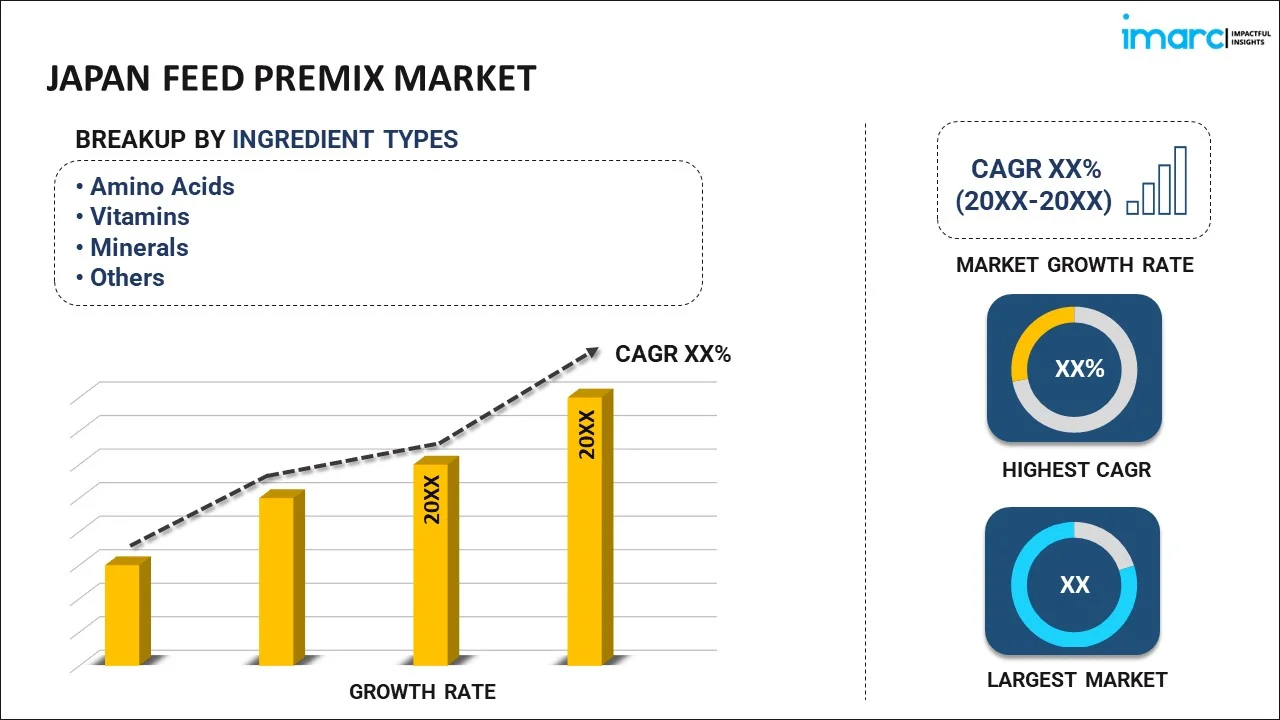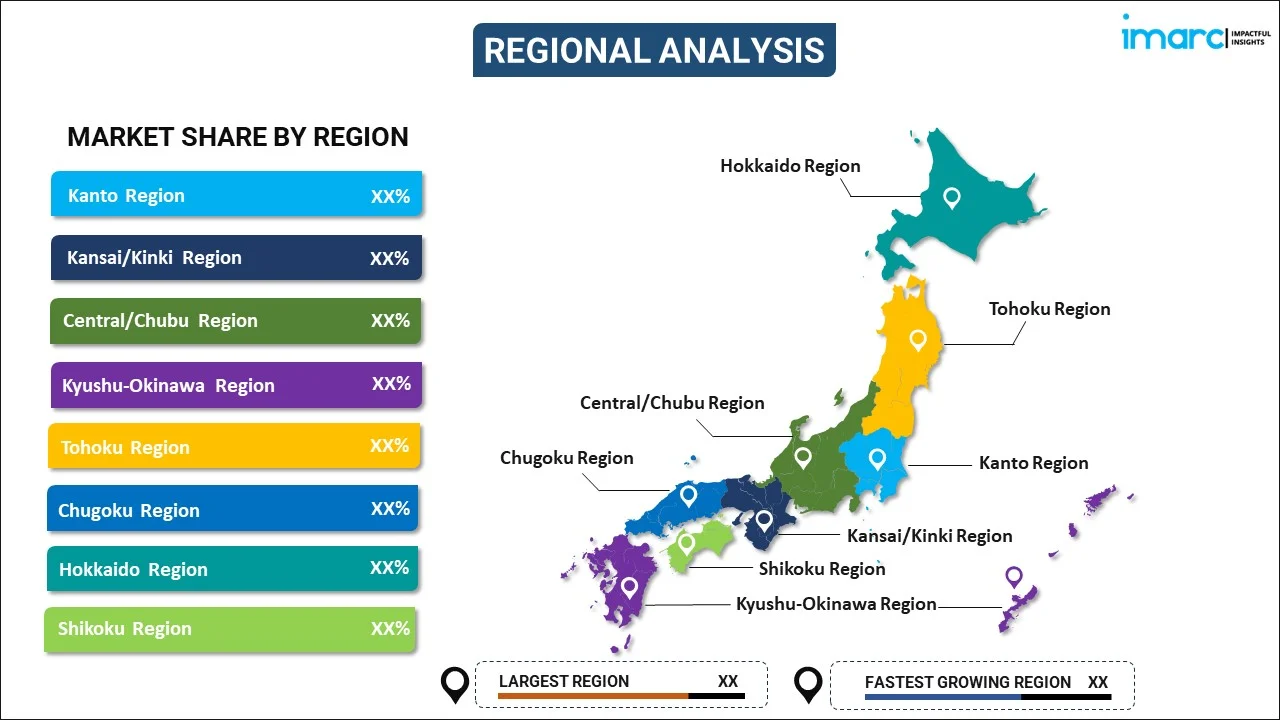
Japan Feed Premix Market Report by Ingredient Type (Amino Acids, Vitamins, Minerals, Antibiotics, Antioxidants, and Others), Form (Dry, Liquid), Livestock (Poultry, Ruminants, Swine, Aquatic Animals, Equine, Pets), and Region 2025-2033
Market Overview:
Japan feed premix market size reached USD 915.7 Million in 2024. Looking forward, IMARC Group expects the market to reach USD 1,449.7 Million by 2033, exhibiting a growth rate (CAGR) of 4.85% during 2025-2033. The rising awareness of the critical role that nutrition plays in animal health and productivity, the escalating demand for meat, dairy, and poultry products, and various technological innovations such as precision nutrition and digital monitoring systems represent some of the key factors driving the market.
|
Report Attribute
|
Key Statistics
|
|---|---|
|
Base Year
|
2024
|
|
Forecast Years
|
2025-2033
|
|
Historical Years
|
2019-2024
|
| Market Size in 2024 | USD 915.7 Million |
| Market Forecast in 2033 | USD 1,449.7 Million |
| Market Growth Rate 2025-2033 | 4.85% |
Feed premix is a specialized blend of vitamins, minerals, trace elements, amino acids, and other essential nutrients that are added to animal feed to ensure the balanced and optimal nutrition of livestock and poultry. This premix is a fundamental component of modern animal agriculture and plays a crucial role in meeting the dietary requirements of animals to promote growth, reproduction, and overall health. These mixes are formulated to address the specific nutritional needs of different animal species, such as poultry, swine, cattle, and fish, as well as various production stages, including growth, reproduction, and lactation. They are typically incorporated into the animal's diet in small quantities but have a significant impact on their overall well-being and performance. Feed premixes are typically mixed with other feed ingredients, including grains, protein sources (such as soybean meal), and fats, to create complete and balanced animal diets. Farmers and livestock producers rely on these premixes to simplify the process of providing the right nutrients to their animals, ultimately leading to healthier and more productive livestock and poultry populations.
Japan Feed Premix Market Trends:
In recent years, there has been a heightened awareness of the critical role that nutrition plays in animal health and productivity. This awareness has prompted a surge in demand for high-quality feed premixes that can provide animals with the necessary nutrients to thrive. Businesses in the feed premix industry are capitalizing on this trend by offering specialized and customized premix solutions tailored to the unique nutritional requirements of different animal categories. In addition, Japan's livestock sector is expanding, with an emphasis on improving the efficiency of animal farming. The growing population's demand for meat, dairy, and poultry products is driving the need for optimized animal diets. Feed premixes are integral to achieving this goal by ensuring that animals receive balanced and nutritionally rich feed, leading to better growth rates and meat quality. Besides, the Japanese government has been actively promoting food safety and quality standards. This includes regulations regarding the use of additives and supplements in animal feed. Companies operating in the feed premix market are aligning with these regulations, focusing on the development of safe and compliant products. Adherence to these standards enhances their reputation in the market and instills trust among consumers. Moreover, technology is playing a pivotal role in the evolution of the feed premix industry. Innovations such as precision nutrition and digital monitoring systems are enabling more accurate and tailored feed formulations. Businesses are leveraging data-driven insights to create premix solutions that optimize animal health and minimize waste, enhancing cost-effectiveness for livestock producers. Furthermore, the Japan feed premix market is witnessing a consolidation phase, with larger players acquiring smaller companies to expand their product portfolios and geographic reach. Additionally, strategic alliances between feed premix manufacturers, livestock producers, and research institutions are fostering innovation and knowledge exchange, benefiting the entire industry.
Japan Feed Premix Market Segmentation:
IMARC Group provides an analysis of the key trends in each segment of the market, along with forecasts at the country level for 2025-2033. Our report has categorized the market based on ingredient type, form, and livestock.
Ingredient Type Insights:

- Amino Acids
- Vitamins
- Minerals
- Antibiotics
- Antioxidants
- Others
The report has provided a detailed breakup and analysis of the market based on the ingredient type. This includes amino acids, vitamins, minerals, antibiotics, antioxidants, and others.
Form Insights:
- Dry
- Liquid
A detailed breakup and analysis of the market based on the form have also been provided in the report. This includes dry and liquid.
Livestock Insights:
- Poultry
- Ruminants
- Swine
- Aquatic Animals
- Equine
- Pets
The report has provided a detailed breakup and analysis of the market based on the livestock. This includes poultry, ruminants, swine, aquatic animals, equine, and pets.
Regional Insights:

- Kanto Region
- Kansai/Kinki Region
- Central/ Chubu Region
- Kyushu-Okinawa Region
- Tohoku Region
- Chugoku Region
- Hokkaido Region
- Shikoku Region
The report has also provided a comprehensive analysis of all the major regional markets, which include Kanto Region, Kansai/Kinki Region, Central/ Chubu Region, Kyushu-Okinawa Region, Tohoku Region, Chugoku Region, Hokkaido Region, and Shikoku Region.
Competitive Landscape:
The market research report has also provided a comprehensive analysis of the competitive landscape in the market. Competitive analysis such as market structure, key player positioning, top winning strategies, competitive dashboard, and company evaluation quadrant has been covered in the report. Also, detailed profiles of all major companies have been provided.
Japan Feed Premix Market Report Coverage:
| Report Features | Details |
|---|---|
| Base Year of the Analysis | 2024 |
| Historical Period | 2019-2024 |
| Forecast Period | 2025-2033 |
| Units | Million USD |
| Scope of the Report | Exploration of Historical and Forecast Trends, Industry Catalysts and Challenges, Segment-Wise Historical and Predictive Market Assessment:
|
| Ingredient Types Covered | Amino Acids, Vitamins, Minerals, Antibiotics, Antioxidants, Others |
| Forms Covered | Dry, Liquid |
| Livestocks Covered | Poultry, Ruminants, Swine, Aquatic Animals, Equine, Pets |
| Regions Covered | Kanto Region, Kansai/Kinki Region, Central/ Chubu Region, Kyushu-Okinawa Region, Tohoku Region, Chugoku Region, Hokkaido Region, Shikoku Region |
| Customization Scope | 10% Free Customization |
| Post-Sale Analyst Support | 10-12 Weeks |
| Delivery Format | PDF and Excel through Email (We can also provide the editable version of the report in PPT/Word format on special request) |
Key Questions Answered in This Report:
- How has the Japan feed premix market performed so far and how will it perform in the coming years?
- What has been the impact of COVID-19 on the Japan feed premix market?
- What is the breakup of the Japan feed premix market on the basis of ingredient type?
- What is the breakup of the Japan feed premix market on the basis of form?
- What is the breakup of the Japan feed premix market on the basis of livestock?
- What are the various stages in the value chain of the Japan feed premix market?
- What are the key driving factors and challenges in the Japan feed premix?
- What is the structure of the Japan feed premix market and who are the key players?
- What is the degree of competition in the Japan feed premix market?
Key Benefits for Stakeholders:
- IMARC’s industry report offers a comprehensive quantitative analysis of various market segments, historical and current market trends, market forecasts, and dynamics of the Japan feed premix market from 2019-2033.
- The research report provides the latest information on the market drivers, challenges, and opportunities in the Japan feed premix market.
- Porter's five forces analysis assist stakeholders in assessing the impact of new entrants, competitive rivalry, supplier power, buyer power, and the threat of substitution. It helps stakeholders to analyze the level of competition within the Japan feed premix industry and its attractiveness.
- Competitive landscape allows stakeholders to understand their competitive environment and provides an insight into the current positions of key players in the market.
Need more help?
- Speak to our experienced analysts for insights on the current market scenarios.
- Include additional segments and countries to customize the report as per your requirement.
- Gain an unparalleled competitive advantage in your domain by understanding how to utilize the report and positively impacting your operations and revenue.
- For further assistance, please connect with our analysts.
 Inquire Before Buying
Inquire Before Buying
 Speak to an Analyst
Speak to an Analyst
 Request Brochure
Request Brochure
 Request Customization
Request Customization




.webp)




.webp)












